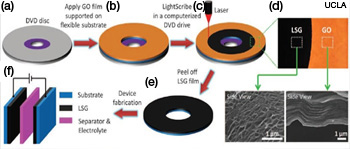Scatterings
Better Super-Capacitors from Laser-Scribed Graphene
Researchers from the University of California, Los Angeles (U.S.A.) used a common computer optical drive to convert thin layers of graphite oxide into graphene, which was then incorporated into flexible electrochemical capacitors.
 (a, b) A graphite oxide film on a flexible substrate is attached to a DVD and inserted into a LightScribe drive. (c, d) The IR laser in the LightScribe drive removes oxygen from the film, converting it to a thin layer of graphene with a large surface area. The color changes from brown to black. (e, f) The graphene film is used as an electrode in a flexible supercapacitor with power and energy densities comparable to batteries.
(a, b) A graphite oxide film on a flexible substrate is attached to a DVD and inserted into a LightScribe drive. (c, d) The IR laser in the LightScribe drive removes oxygen from the film, converting it to a thin layer of graphene with a large surface area. The color changes from brown to black. (e, f) The graphene film is used as an electrode in a flexible supercapacitor with power and energy densities comparable to batteries.
Researchers from the University of California, Los Angeles (U.S.A.) used a common computer optical drive to convert thin layers of graphite oxide into graphene, which was then incorporated into flexible electrochemical capacitors (ECs, also called supercapacitors or ultracapacitors). The ECs with these laser-scribed graphene electrodes offer better—possibly breakthrough—performance that could make them competitive with batteries. Researchers Maher F. El-Kady, Veronica Strong, Sergey Dubin and Richard B. Kaner used a standard LightScribe DVD optical drive to make electrodes for ECs that demonstrated high energy densities, high conductivity and good physical and electrical stability (Science 335, 1326).
…Log in or become a member to view the full text of this article.
This article may be available for purchase via the search at Optica Publishing Group.
Optica Members get the full text of Optics & Photonics News, plus a variety of other member benefits.
